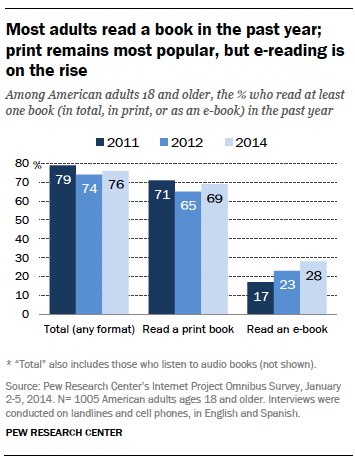Technology and the internet are changing Americans’ reading habits and also their relationship with libraries. Half of Americans now own a tablet or e-reader and libraries have responded by expanding their digital offerings.
But what hasn’t changed is Americans’ love for books. American adults still read about as much as ever and overwhelmingly say libraries play an important role in their communities. In advance of the American Library Association’s Midwinter Convention (#alamw14) in Philadelphia, here are some key facts and trends we have chronicled in our research on America’s public libraries.
1E-book reading is growing, but printed books still dominate the reading world. 28% of American adults ages 18 and older read an e-book in the past year, up from 17% in 2011. Still, 69% read a printed book, about the same as last year. Only 4% of readers are “e-book only” readers. The vast majority of e-book readers also read a printed book. (Report)

2The rise of e-book reading is tied to the steady increase in ownership of tablet computers and e-readers. 50% of adults now own either a tablet computer or an e- reader. Ownership of both devices jumped this year during the holiday gift-giving season. But people also read e-books on their cell phones (32% of e-book readers did that in the past 12 months) and on desktop or laptop computers (29% of e-book readers did that in the past 12 months). (Report)

3Americans appreciate libraries, especially for the role they play in communities. 90% of Americans say the closing of their local public library would impact their community and 67% said it would affect them and their families. (Report)

4Mothers love libraries. Mothers are more likely than fathers to read to their children every day (55% vs. 45%). Mothers are also more likely than fathers to have a library card and to have visited a library in the past year. (Report)

5Access to books, media, and quiet, safe reading places top the list of favorite library services. 80% of Americans say no-cost access to books and media is the most important service libraries provide, followed by librarian assistance (76%), having a quiet and safe place to read (75%) and research resources (72%). (Report)

6The public’s highest priorities for libraries center on kids and literacy. 85% of Americans say libraries “should definitely” coordinate more closely with local schools. And 82% believe libraries should provide free literacy programs to young children, which may include traditional reading, writing and comprehension as well as technology and new media literacies. (Report)

7Library websites are catching on. 44% of those ages 16 and older have ever used a library website, up from 39% in 2012, and 30% used one in the past 12 months. Website users tend to be higher income and well educated. (Report)
8Older teens and young adults are sometimes the most likely to desire new library technologies. 45% of young adults would very likely use a mobile GPS app to find material inside the library. They’re also the most likely to say they would use Redbox-style kiosks to check out library books or movies if they were placed around their towns. (Report)
9One challenge libraries face is simply making people aware of all the services they offer. 30% of library users say they know little or nothing about the services their library provides. (Report)
10Library use ebbs and flows for many Americans. 26% of library patrons say their use has gone up in the past 5 years; 22% say it has gone down. (Report) Just before the Public Library Association conference in March, the Pew Research Center will issue a special report on a survey of 6,200 Americans showing there are 7 distinct groups of library users and 2 distinct groups of non-users of libraries, each with its own habits, priorities, and demographic makeup. (Sign up to be notified of this report when it is published.)
[callout]Read more about Americans and libraries:
- Most Americans say libraries can help them find reliable, trustworthy information
- Millennials are the most likely generation of Americans to use public libraries
- Who doesn’t read books in America?


